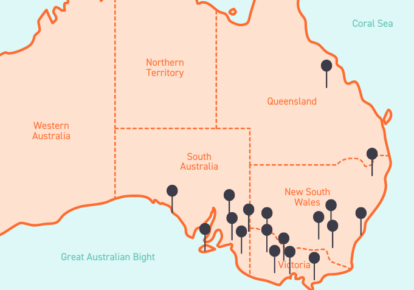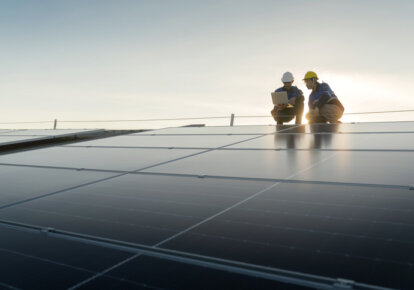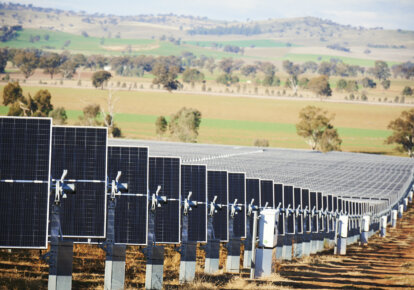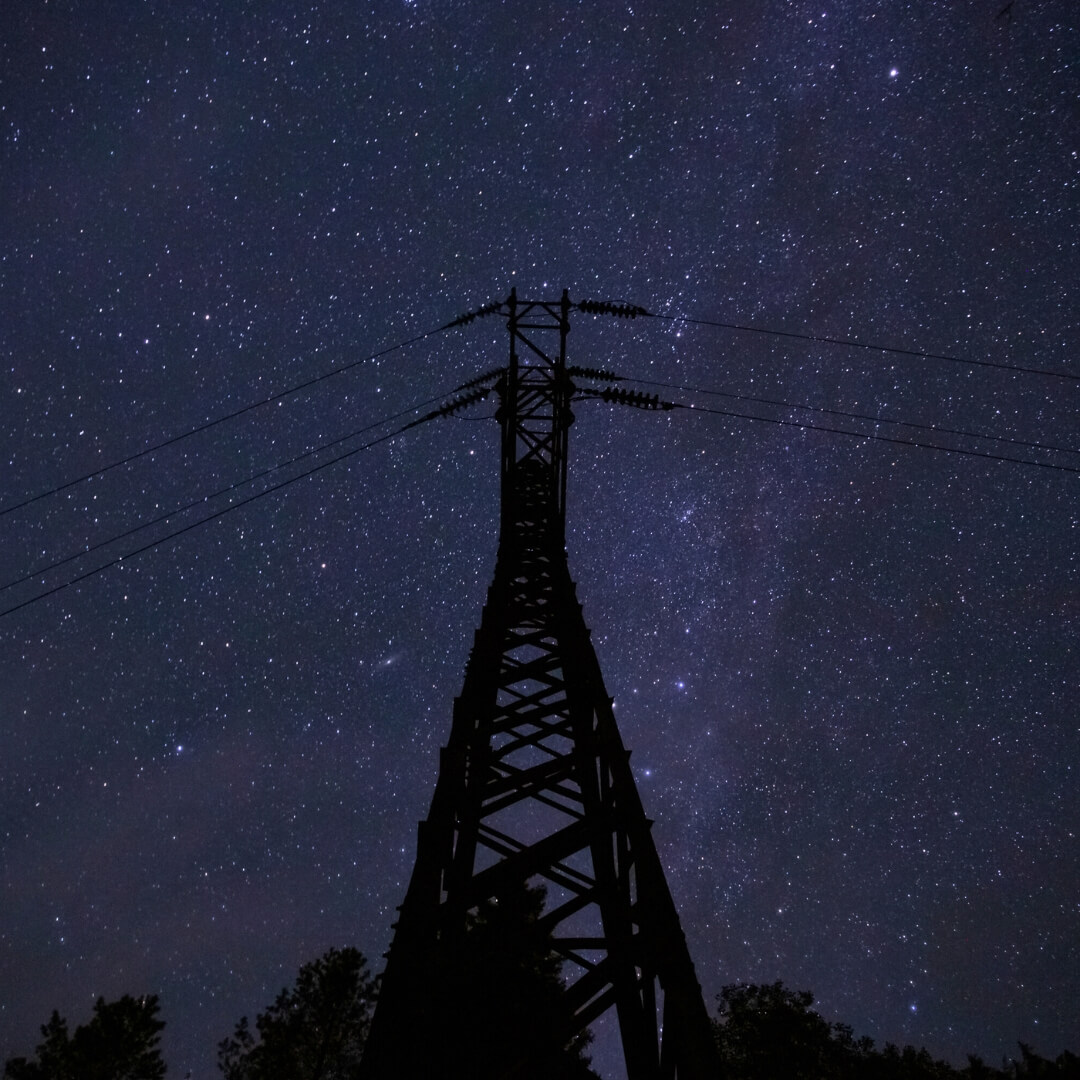September saw a dip in spot prices to levels not seen since spring 2023, with average spot prices at their lowest since the year began. Where August saw extreme price volatility leading to the highest ever daily average price, September saw a record number of negatively priced intervals. Low demand due to reduced heating demand, along with renewable generation availability were the key drivers.
Electricity price insights
The most significant event for the month occurred in South Australia on the 23rd of September. Low wind conditions combined with a constrained SA-VIC interconnector (which limits the amount of power that can be shared between South Australia and Victoria) resulted in low availability of supply and price volatility in South Australia. Electricity spot prices in the South Australia hovered around $10,000/MWh for 2 hours in the evening. This low level of supply had been forewarned by the Australian Energy Market Operator (AEMO), who forecasted Lack of Reserve conditions in the region earlier in the day.
If we remove the 23rd of September from our analysis, the average price in South Australia for September would decrease by more than 50%. This highlights the impact of extreme prices on electricity costs and the value of being able to respond to price signals by adjusting electricity behaviour during high price periods.
Wind generation continues to be the driving force behind South Australia’s spot price where lower wind generation days typically correspond to higher average daily spot prices, and vice versa. This trend is strongest when the interconnector between South Australia and Victoria is constrained. The availability of an unconstrained interconnector reduces the likelihood of extreme price volatility. While prices will still be typically higher on a low-wind day, they may not necessarily exceed $1,000/MWh if the interconnector can allow Victorian generation to flow into South Australia to help address a generation shortfall.
September also highlighted the impact of increased rooftop solar generation. While this was not evident in the amount of total rooftop solar in the grid, it was visible in the deepening belly of the demand duck curve (the duck curve refers to the shape of electricity demand, which is high in the morning and evening and low during the middle of the day). Peak evening demand for September was similar to those in previous years, although the middle of the day demand was lower. This was particularly evident in New South Wales, where a new minimum demand record set in the month.
This is not all good news as AEMO issued its second ever minimum system load market notices for Victoria in the last few days of September. This means that AEMO detected an elevated risk of insufficient demand to maintain a secure operating state in the Victorian region. These notices are new, but likely to be a regular feature of future shoulder seasons, where low demand (before the cooling demand of summer) coincides with high rooftop solar generation. This also highlights the broader benefits to the stability of the power system provided by load shifting. If customers can consume more of their electricity during the middle of the day, not only does this typically coincide with low wholesale prices, but it also helps maintain the security of the broader power system.
Total renewable share of generation hit a record high in the month, with 45.16% of all electricity generated coming from renewable sources across the network.
Changes in forward contract prices for CY25
Forward prices for 12-month futures in all mainland regions were stable during September, finishing the month at very similar levels to those at the end of August.

- New South Wales prices are down 6% from a year ago, and 1% from August 2024
- Queensland prices are up less than 1% from a year ago, and down 2% from August 2024
- South Australia prices are down 9% from a year ago, and 1% from August 2024
- Victoria prices are down less than 1% from a year ago, and up less than 1% from August 2024
September 2024 NEM insights by state
New South Wales

- Average spot price of $58/MWh, with 163 hours of negative prices and just over 1 hour above $300/MWh
- $180/MWh difference in average underlying spot prices at the cheapest and most expensive times of day
- Average prices were negative for all periods between 10:00 AM and 2:00 PM during the month
- A record 41% total renewable generation through the month
- New minimum demand record of 4,061 MW
- Peak demand of 10,420 MW
Queensland

- Average spot price of $50/MWh, with 233 hours of negative prices and just under 1 hour above $300/MWh
- $200/MWh difference between the average underlying prices at the cheapest and most expensive times of day
- Average prices were negative for all periods between 8:00 AM and 4:00 PM during the month
- 33% total renewable generation through the month
- Minimum demand of 3,797 MW
- Peak demand of 8,128 MW
South Australia

- Average spot price of $80/MWh, with 317 hours of negative prices and 10 hours above $300/MWh
- $190/MWh difference between the average underlying prices at the cheapest and most expensive times of the day
- Average prices were negative for all periods between 8:30 AM and 4:30 PM during the month
- 86% total renewable generation through the month
- Minimum demand of 148 MW
- Peak demand of 2,085 MW
Tasmania

- Average spot price of $23/MWh, with 215 hours of negative prices and only one 5-minute interval above $300/MWh
- $90/MWh difference between lowest and highest time-based average underlying spot price
- Average prices were close to 0 or negative for all periods between 9:00 AM and 4:00 PM during the month
- More than 99% total renewable generation through the month
- Minimum record of 915 MW
- Peak demand of 1,629 MW
Victoria

- Average spot price of $17/MWh, with 283 hours of negative prices and no intervals above $300/MWh
- $150/MWh difference between lowest and highest time-based average underlying spot price
- Average prices were negative for all periods between 8:30 AM and 4:00 PM during the month
- A record 42% total renewable generation through the month
- Minimum demand of 2,040 MW
- Peak demand of 7,585 MW
September temperatures
Spring has sprung for much of the National Electricity Market (NEM), with September coming in as the fourth hottest (based on mean temperature) September on record. This was especially pronounced in Queensland where mean daily temperatures were at least 1 degree above average. It was a relatively dry September across the NEM, with all mainland regions recording less rainfall than average when compared to previous Septembers. However, Tasmania and Western Australia ranked in the top 10 for total rainfall for all Septembers.
Looking ahead to October
Spring conditions look to be well established as we move into October. We expect to see low and negative prices during the daytime when solar is abundant, and extended periods of negative prices during periods of higher wind output.
In September, we saw renewable generation records being broken and new minimum demands in Victoria and New South Wales. The milder weather of October, along with more favourable renewable generation conditions may see these records surpassed.
During this shoulder season, demand is typically low, and renewable generation is starting to increase from the seasonal winter lows. Also called “the goldilocks season”, many coal generators are taking advantage of the seasonal drop in demand to undertake required maintenance. These outages are important to maintain the reliability of generation during the coming summer, when hot temperatures can stress the capacity of the system.
As a reminder, ongoing maintenance of both generating units and transmission lines could cause periods of high price volatility, particularly in the evening peaks or in South Australia where interconnection with the rest of the NEM is weaker.
The Bureau’s climate models remain in a weak “La Niña Watch” indicating that there are signs a La Niña may develop later this year. This would bring cooler than average maximum temperatures across most of mainland Australia (south of the tropics) and increased rainfall. The signals of a La Niña have been weakening, with increasing likelihood of a neutral El Niño–Southern Oscillation event. Looking further, current modelling indicates that if La Niña conditions were to develop, it would be relatively weak and short lived.
Any questions? Our energy specialists are here to help.
If you’re an existing Flow Power customer, don’t hesitate to reach out to your account manager.
If you’re not a Flow Power customer, feel free to contact our friendly team:
1300 08 06 08
Alternatively, you can submit your questions through our website contact form here.














